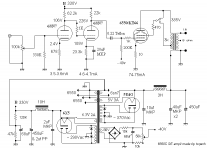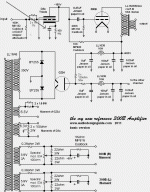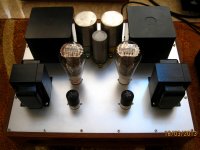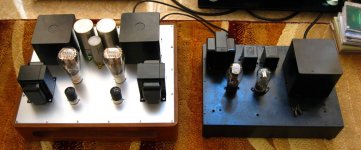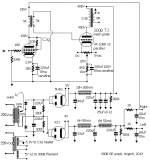The D3A would be a great choice and since you have it on hand.. Choke load or IT couple it to a fixed bias or cathode biased 300B.. I'll post something over the next few days - I've used D3A with Lundahl 1635 IT to drive copper plate GM70 with very good results, something similar should work quite nicely for the 300B.
Hi Garbo,
D3a is very good tube. an other choice is maybe E810F, 5842/ 417A or 6C45P.
If you like sweet, warm and silked sound in the Jazz, Country, Instruments.... you can have regard to 6SN7 in which 1 triode is directly coupled to another. sound quality depends much on quality of your parts. in my ampli, I use totally AB resistors and many film capacitors.
here is my schema. sound is really attractive.
Attachments
Last edited:
You are right some audio signal will also go that way. Any alternating voltage, audio signal or noise signal will follow any path to a steady (non-alternating) node, either gnd or b+. In this case 1/10 of the audio signal will go to b+ since the cap to gnd is 10 times as large as the one to b+.
The problem here is that audio signal will be bypassed through that C not linearity/ not equally. So freq response is not flat ?
The problem here is that audio signal will be bypassed through that C not linearity/ not equally. So freq response is not flat ?
No it doesnt matter if bypassing goes to gnd or b+, but any steady state node gnd or b+, needs to be real 'steady'. The effect is like having a 10uF in parallel with 100uF as far as the audio signal is concerned. The point is to bypass the cathode so it is the tube's reference point for the grid.
In a SE design you have no benefit of the ripple cancelation you have in a PP design. Since SE runs class-A with high current, it is usual to have relatively high ripple on b+ and hum on the output, espescially with low rp tubes such as triodes. So a trick is to inject some ripple out of phase into the cathode. It really does reduce hum but I find I need to experiment a bit with the final values, (parallel small caps over the large untill I get it right).
Thanks Kev for correcting me, I always seem to round off that '+1' factor since I usually end up fine-tuning the values after build anyways.
Hi Garbo,
D3a is very good tube. an other choice is maybe E810F, 5842/ 417A or 6C45P.
If you like sweet, warm and silked sound in the Jazz, Country, Instruments.... you can have regard to 6SN7 in which 1 triode is directly coupled to another. sound quality depends much on quality of your parts. in my ampli, I use totally AB resistors and many film capacitors.
here is my schema. sound is really attractive.
Nice design tcqanh.
I wonder though if AC coupling the two 6SN7s is just as good, maybe better for that last 6SN7 because it gets more voltage to swing around. it is no more AC coupled than your schema because it doesn't matter if the cap is from one stage to the next, or if the cap is bypassing a large cathode resistor, that cap is just as much 'in the signal path'. It would perhaps be an interesting experiment.
Hello
Found something here. These interesting, I know Andrea build quality stuff!
the new reference 300B amplifier
Again these would be a step up to me to build a GM70 SE tube amp. I want to start with a lower voltage to get back into the tube world....
Greetings Gabor
Found something here. These interesting, I know Andrea build quality stuff!
the new reference 300B amplifier
Again these would be a step up to me to build a GM70 SE tube amp. I want to start with a lower voltage to get back into the tube world....
Greetings Gabor
Last edited:
It shunts some power supply ripple to the cathode to cancel the ripple on the output. The value of the cap from cathode to b+ should be [(C cathode to gnd)/mu]. I've found some fiddling with the final value necessary for complete ripple cancelation.
You'll find lots of this at tubecad.com...
This technique works exceptionally well.
Read this: Lowering SE Amplifier Noise (page 2)
I use motor run capacitors in the upper C1 position and tune the cathode by-pass capactor with small value films if necessary.
Ian
Best sounding in pentode mode (on my plan) : 12GN7, 12HG7, EL802, EL183E
I have done similar, but use DC heaters and get rid of the hum-buck pot. Then connect the cathode-by-pass at the heaters.
Also, ever try a 6sn7 cathode follower (broskie style) after the D3a?
The D3a has lowish ~2k2 output impedance, but a cathode follower should be even better...
Hello
I'm still in the process collecting the parts for my 300B.
I have several question
Can I use other 10H choke because the LL1638 a bit pricey.
Like Hammond 159P??
Also I have a pair new Transcendental 3.5K OP transformer. Andrea use 5.6K in these circuit.
Can I use my transformer with out a major modification?
From these circuit also missing one capacitor value.
Kevin if you have at your hand your 300B (circuit) driven by D3a tube it would be great to share with us.
Please! Thank you
Greetings Gabor
I'm still in the process collecting the parts for my 300B.
I have several question
Can I use other 10H choke because the LL1638 a bit pricey.
Like Hammond 159P??
Also I have a pair new Transcendental 3.5K OP transformer. Andrea use 5.6K in these circuit.
Can I use my transformer with out a major modification?
From these circuit also missing one capacitor value.
Kevin if you have at your hand your 300B (circuit) driven by D3a tube it would be great to share with us.
Please! Thank you
Greetings Gabor
Attachments
Are those Hammond 126B (or 126C) interstages?
I bought these ITs from a friend. He don't know their origin. I suspect they from Hammond cause of the same style, but not sure. These use Fe 32mmx50mm and their size is equal an OPT Tango U808. 126B is much smaller.
I bought these ITs from a friend. He don't know their origin. I suspect they from Hammond cause of the same style, but not sure. These use Fe 32mmx50mm and their size is equal an OPT Tango U808. 126B is much smaller.
Thanks, I was just curious as the 126B seems a very nice interstage and is cheap. Indeed the U808 has almost double the volume as the 126B, so it is a sort of 'misterious' IT then
BTW, very nice looking amplifier!
I'm obviously partial to my design... 300B driven by a 6N6P (with options for using ECC99 or 12BH7A as well).
http://www.diyaudio.com/forums/tubes-valves/218217-deathtrap400-pretty-damn-good-300b-amp.html
~Tom
http://www.diyaudio.com/forums/tubes-valves/218217-deathtrap400-pretty-damn-good-300b-amp.html
~Tom
would like to ask you...is the 5k optimal load for triode connected C3g ?
The internal resistance- Ri of C3g is about 2.3K in this case, So loading 2-3 times of Ri will be good choice.
How loading is optimal ? ... I'm not sure, but the higher loading the worse quality.
Thanks, I was just curious as the 126B seems a very nice interstage and is cheap. Indeed the U808 has almost double the volume as the 126B, so it is a sort of 'misterious' IT then
BTW, very nice looking amplifier!
TKs,
I think my huge IT pair is kind of customer oder from somewhere. Maybe it can run 50-60mA.
- Status
- This old topic is closed. If you want to reopen this topic, contact a moderator using the "Report Post" button.
- Home
- Amplifiers
- Tubes / Valves
- Recommended 300B SE Amplifier Designs
